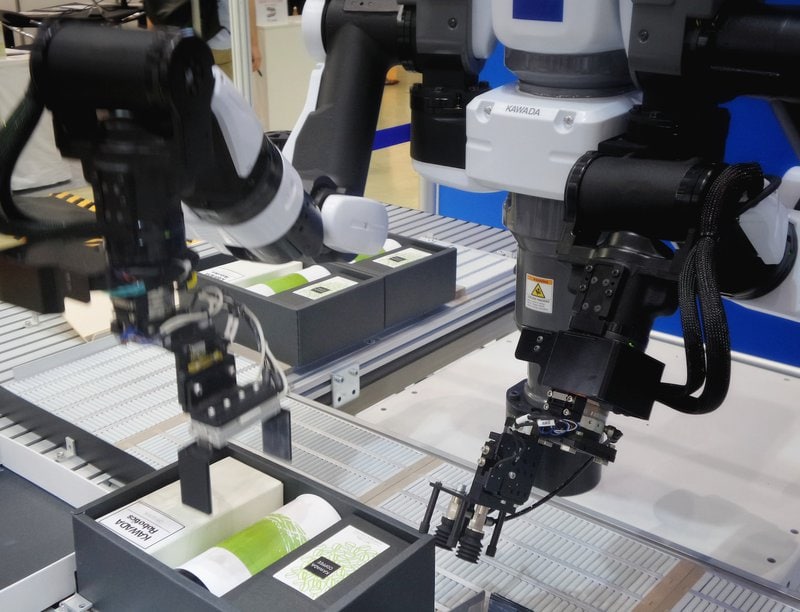What Is the Intersection of AI and Robotics

Are you curious about the intersection of AI and robotics? Do you want to know how these two cutting-edge technologies are coming together to shape our future?
In this article, we will explore the evolution of AI and robotics, the applications and advancements in this field, the challenges and opportunities it presents, and the ethical considerations surrounding it.
Get ready to dive into the exciting world where artificial intelligence meets robotics.
Key Takeaways
- AI and robotics have evolved together, with each influencing the other’s development.
- The integration of AI and robotics has led to significant advancements in autonomous vehicles, healthcare robotics, and industrial automation.
- AI-powered robots in healthcare can perform complex tasks such as surgery, patient monitoring, and diagnosis, improving patient care and reducing human error.
- The integration of AI and robotics raises ethical considerations such as job displacement, privacy, and biased decision-making, necessitating clear guidelines and regulations for responsible development and use.
The Evolution of AI and Robotics
You’re probably wondering how AI and robotics have evolved over time. Well, let’s take a closer look at the evolutionary trends and technological convergence that have shaped these fields.
Over the years, AI and robotics have gone hand in hand, with each influencing the other’s development. Initially, AI focused on developing intelligent systems capable of mimicking human behavior and decision-making. On the other hand, robotics aimed at building machines that could perform physical tasks autonomously.
However, with the advancement of technology, we have witnessed a convergence between these two fields. Today, AI and robotics work together seamlessly, with AI algorithms powering robotic systems and enabling them to learn, adapt, and make decisions on their own.
This integration has led to significant advancements in areas such as autonomous vehicles, healthcare robotics, and industrial automation. The evolutionary trends and technological convergence in AI and robotics continue to push the boundaries of what is possible, and we can only imagine what the future holds.
Applications and Advancements in AI and Robotics
In this discussion, let’s explore the exciting developments in AI and robotics. Specifically, we will focus on two key points: AI in healthcare robotics and the ethical considerations surrounding AI and robotics.
Firstly, we will examine how AI is revolutionizing the healthcare industry by enhancing the capabilities of robotic systems. With advancements in AI technology, robots are now able to perform complex tasks such as surgery, patient monitoring, and even diagnosis. This integration of AI and robotics in healthcare has the potential to greatly improve patient care, increase efficiency, and reduce human error. We will explore the various applications of AI in healthcare robotics and discuss the potential benefits it brings to the industry.
Secondly, we will delve into the ethical dilemmas that arise from the integration of AI and robotics in various fields. As AI becomes more sophisticated and autonomous, questions surrounding its impact on human society and the workforce arise. We will discuss issues such as job displacement, privacy concerns, and the potential for AI to make biased decisions. It is important to consider the ethical implications of AI and robotics to ensure that these technologies are developed and utilized responsibly.
AI in Healthcare Robotics
There’s a growing application of AI in healthcare robotics, enabling machines to assist in various medical procedures. This intersection of AI and robotics is transforming the field of healthcare, bringing numerous benefits and advancements.
Here’s how AI is making a significant impact in healthcare robotics:
- AI and robotics in surgery: Advanced robotic systems are now being used to assist surgeons in performing complex procedures with precision and accuracy. These robots can analyze medical data, provide real-time feedback, and even perform certain tasks autonomously.
- AI and robotics in elderly care: With an aging population, there is an increasing need for robotics to support the elderly. AI-powered robots can assist with daily activities, monitor vital signs, and provide companionship, improving the quality of life for older adults.
- AI and robotics in diagnostics: Machine learning algorithms can analyze medical images and patient data to aid in the early detection and diagnosis of diseases. This helps healthcare professionals make more accurate and timely decisions, leading to better patient outcomes.
AI in healthcare robotics has the potential to revolutionize the way medical procedures are performed and patient care is delivered. With continued advancements, we can expect to see even more innovative applications in the future.
Ethical Considerations in AI and Robotics
When considering the ethical implications of utilizing artificial intelligence and robotics in healthcare, it is crucial to address the potential impact on patient privacy and data security. As a society, we must carefully navigate the ethical considerations that arise from the integration of AI and robotics into healthcare systems.
The advancements in AI and robotics have the potential to revolutionize healthcare by improving diagnosis, treatment, and patient care. However, the collection and use of personal health data raises concerns about privacy and security. It is important to ensure that patient information is protected and used responsibly.
Additionally, there is a need to establish clear guidelines and regulations to govern the use of AI and robotics in healthcare to minimize potential risks and ensure the well-being of patients. By addressing these ethical considerations, we can harness the benefits of AI and robotics while safeguarding patient privacy and data security.
Challenges and Opportunities in the AI-Robotics Intersection
In this discussion, you’ll explore the ethical implications of AI-Robotics and advancements in autonomous systems.
As technology advances, questions arise about the ethical boundaries and implications of using AI and robotics in different industries and sectors.
You’ll also delve into the latest advancements in autonomous systems, considering the benefits and challenges they present in our society.
Ethical Implications of Ai-Robotics
You should consider the ethical implications of AI-robotics. As this technology continues to advance, it is crucial to understand the ethical considerations and societal implications that come with it.
Here are three important points to consider:
- Privacy: AI-robotics can collect vast amounts of personal data, raising concerns about privacy and data security. It is essential to establish regulations and safeguards to protect individuals’ privacy rights.
- Job displacement: The integration of AI and robotics may lead to job displacement, impacting various industries and communities. It is important to address the potential social and economic consequences and develop strategies to mitigate the impact.
- Autonomous decision-making: AI-robotics have the ability to make decisions autonomously, raising questions about accountability and responsibility. It is crucial to establish guidelines and regulations to ensure that these systems make ethical decisions and can be held accountable for their actions.
Considering these ethical implications is essential to ensure that AI-robotics benefit society while safeguarding individuals’ rights and well-being.
Advancements in Autonomous Systems
Advancements in autonomous systems have revolutionized various industries and transformed the way tasks are performed. One of the most notable areas where these advancements have made a significant impact is in the realm of autonomous vehicles. These self-driving cars have the potential to revolutionize transportation by reducing accidents and improving efficiency. In addition to autonomous vehicles, industrial automation has also benefited greatly from advancements in autonomous systems. This technology has allowed for the automation of repetitive and dangerous tasks, increasing productivity and safety in various industries.
| Advantages | Challenges | Applications |
|---|---|---|
| – Increased safety – Improved efficiency – Reduced human error |
– Ethical concerns – Technical limitations – Cost of implementation |
– Transportation – Manufacturing – Warehousing |
Autonomous vehicles and industrial automation are just two examples of how autonomous systems are transforming industries. As technology continues to advance, we can expect to see even more innovative applications that will further revolutionize the way tasks are performed.
Ethics and the AI-Robotics Nexus
As we delve into the ethics of the AI-robotics nexus, it’s crucial to consider the potential implications for human rights and social justice. The rapid advancement of AI and robotics technology brings with it a myriad of ethical dilemmas and social implications.
AI bias: With the increasing use of AI algorithms in decision-making processes, there is a risk of perpetuating existing biases and discrimination.
Job displacement: The automation of tasks through AI and robotics can lead to job losses and economic inequality.
Privacy and surveillance: The collection and analysis of vast amounts of data by AI systems raise concerns about the invasion of privacy and the potential for surveillance.
These ethical challenges highlight the need for robust regulations and frameworks to ensure that AI and robotics are developed and used in ways that uphold human rights and promote social justice.
It is essential to address these issues proactively to shape a future where AI and robotics benefit society as a whole.
The Future of AI and Robotics
The future of AI and robotics looks promising, with the potential to revolutionize various industries and improve our daily lives. Technological advancements in AI and robotics have already had significant impacts, and the future implications are even more exciting.
From healthcare and transportation to manufacturing and communication, AI and robotics have the potential to streamline processes, increase efficiency, and enhance the overall quality of life. Imagine having self-driving cars that reduce accidents and traffic congestion, or robotic assistants that can perform complex surgeries with precision.
These advancements will not only make our lives easier but also create new job opportunities and drive economic growth. As we continue to push the boundaries of AI and robotics, the future is filled with endless possibilities and exciting advancements.
Industries Impacted by the Confluence of AI and Robotics
Imagine how AI and robotics are transforming various industries, from healthcare to manufacturing, and improving efficiency and productivity. The integration of AI and robotics has brought numerous benefits to these industries, revolutionizing their operations and opening up new possibilities. Here are three examples of industries impacted by AI and robotics:
- Healthcare: AI and robotics are being used to automate repetitive tasks, such as patient data analysis, allowing healthcare professionals to focus more on patient care. Surgical robots are also improving precision and minimizing risks during complex procedures.
- Manufacturing: AI-powered robots are streamlining production processes, increasing accuracy, and reducing errors. This integration has led to faster production cycles and improved quality control, ultimately boosting productivity and profitability.
- Transportation: Autonomous vehicles, guided by AI algorithms, are reshaping the transportation industry. From self-driving cars to delivery drones, AI and robotics are enhancing safety, optimizing routes, and reducing environmental impact.
The integration of AI and robotics in these industries is just the beginning, with the potential for even more advancements and benefits in the future.
Frequently Asked Questions
How Does the Integration of AI and Robotics Impact the Job Market and Employment Opportunities?
The integration of AI and robotics has a significant impact on the job market and future employment. It leads to the automation of tasks, potentially replacing certain jobs while creating new opportunities in fields like AI development and robotics engineering.
What Are Some Potential Risks and Concerns Associated With the Use of AI and Robotics in Various Industries?
Privacy concerns and safety risks are two potential issues associated with the use of AI and robotics in various industries. It’s important to address these concerns to ensure the well-being of both individuals and organizations.
How Does the Collaboration Between AI and Robotics Contribute to Advancements in Healthcare and Medical Technology?
Collaboration between AI and robotics contributes to advancements in healthcare and medical technology by improving patient care and enhancing surgical procedures. AI enables robots to assist in surgeries and perform complex tasks with precision and accuracy.
Are There Any Legal or Regulatory Frameworks in Place to Address the Ethical Implications of AI and Robotics?
There are legal and regulatory frameworks in place to address the ethical concerns and legal implications of AI and robotics. These frameworks help ensure that these technologies are developed and used responsibly and in accordance with ethical standards.
What Are Some Key Factors That Will Determine the Rate of Adoption and Acceptance of AI and Robotics in Different Industries?
To determine the rate of adoption and acceptance of AI and robotics in different industries, key factors like cost-effectiveness, scalability, ease of implementation, and potential for increased productivity and efficiency play a crucial role.








